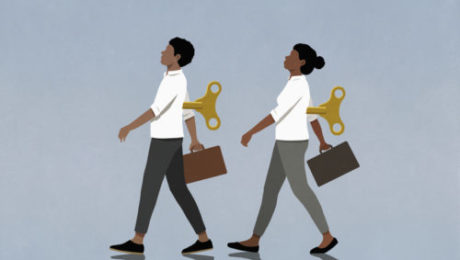How Technology Can Boost Workplace Safety
This article is from RISQ Consulting’s Zywave client portal, a resource available to all RISQ Consulting clients. Please contact your Benefits Consultant or Account Executive for more information or for help setting up your own login.

More than 14 people per day died while doing their jobs in 2016, highlighting the need for safety and procedural enhancements in the workplace. Employers are starting to embrace new technology in an effort to improve worker safety, including the following:
- Exoskeletons—Workers can wear exoskeletons to transfer weight from repetitive tasks and use less energy when moving objects. The result is a reduced risk of injuries as well as increased strength, dexterity and productivity.
- Virtual reality—This technology replicates physical environments and presents training opportunities for employees. It also allows workers to simulate hazardous tasks and identify safety needs. More benefits are expected as technology matures.
- Wearables—Wearable devices offer real-time monitoring of workers’ vital signs and can alert workers to the presence of environmental dangers. They can also cut health care costs by reducing health risks such as respiratory problems, cancer, dermatitis and hearing damage. An added bonus to employers is that wearables can provide an idea of what may have caused an employee’s injury before filing a workers’ compensation claim.
- Hand-held mobile devices—Although the use of mobile devices can be a distraction and safety liability, there are useful apps that detect safety hazards, log safety incidents, track OSHA requirements and even determine when the heat index is too high on job sites. The key to improving worker safety with hand-held mobile devices is using them responsibly.
- Drones—Sending drones into high-hazard areas instead of humans helps safely assess damage and plan emergency response.
INCORPORATING DATA SCIENCE
Aside from new devices, data science has enabled companies to analyze photos from job sites and then scan them for safety hazards, using an algorithm that correlates those images with their accident records.
Although the technology still needs some fine-tuning, companies can use such algorithms to rate project risks. As a result, the technology could prove extremely helpful in detecting elevated threats and then intervening with safety briefings.
TIME TO GET ON THE CLOUD
By using the cloud, companies have been able to completely overhaul the way they interact with each other and with their workers. The cloud consists of multiple networks of servers that allow apps to be accessed anywhere through the internet instead of confined to a particular computer or network.
Businesses that have projects and crews in multiple locations especially appreciate the benefits of the cloud, since it is efficient and allows for the seamless transfer of information and monitoring of workers’ safety.
SUCCESSFULLY DEPLOYING NEW TECHNOLOGY
New technology can be a waste of money if it is not deployed properly. It’s easy to get caught up in the “wow factor” of technology and lose sight of what the intended improvements are. Without a plan in place for deployment, this technological investment may be wasted.
Before seeking out new technology, consider ways to improve workplace processes. After improving these processes, it is easier to identify gaps that new technology can address. No amount of technology will help if it is processes that need to be fixed.
- Published in Blog
Understanding How Habits Work to Influence Safety
This article is from RISQ Consulting’s Zywave client portal, a resource available to all RISQ Consulting clients. Please contact your Benefits Consultant or Account Executive for more information or for help setting up your own login.
As an employer, safety is your responsibility, and it’s important to identify workplace hazards and instill safe employee habits to ensure corrections remain permanent. One way to accomplish this is through behavioral observation, as it can help identify unsafe acts and conditions within a workplace, giving employers insight into potentially dangerous work habits. This article discusses how habits are created, how to change employee habits and ways to identify which behaviors need to change.
Understanding Habits
Habits can be formed in two ways: Through a traumatic psychological experience—such as accidentally touching a hot stove and learning never to do it again—or through repetitive actions the brain turns into automatic function. According to the Society for Personality and Social Psychology, habits make up approximately 40% of human behavior. In terms of workplace safety, it can be difficult to unlearn bad habits employees have formed.
One technique used for creating good habits is known as the “Habit Loop,” in which each behavior within the loop works to form a habit. There are three components that comprise the Habit Loop: A cue, a routine and a reward. For example, getting into a car (the cue), putting on a seatbelt (the routine) and not getting a ticket from the police (the reward) is an example of a Habit Loop. Managers can capitalize on this strategy to help employees form new habits or change old ones.
How to Change Employee Habits
Bad habits can easily become routine if previous outcomes of the action have not been negative. By the time a company notices, the unhealthy behavior may already be ingrained within the worker. To change unsafe habits and mitigate negative outcomes, it’s important to understand which Stage of Change a worker is in.
The Stage of Change theory suggests that a lack of motivation, willpower or confidence may not be to blame when it comes to someone’s inability to change—but rather that someone may not be ready to change or may not recognize that they need to. Understanding a worker’s readiness to change may be the key to determining how to approach moving them along the stages of change. The following are the stages of change and how employers can influence an employee at that stage:
- Pre-contemplation—At this stage, employees are unaware a problem or risk exists. To influence someone at this stage, it’s important to educate and bring awareness to the problem or concern.
- Contemplation—The contemplation stage refers to employees who are starting to consider or thinking about making a change. Continued education and ongoing opportunities for self-evaluation can help employees in this stage.
- Preparation—At this point, employees have decided to make a change in order to move into a new situation. This is an easy phase to get stuck as employees may be unwilling or unable to make the initial step to change. To help employees in this stage, it’s important to evaluate employees on an individual level and determine their intrinsic motivation. Focus on the person, not the company’s wants or needs.
- Action—Here, an employee may start to change their environment, behavior or experience. Managers should provide encouragement, recognition and ongoing positive reinforcement during this stage.
- Maintenance—Now that change has happened and become part of a normal routine, employees may be able to experience the positive outcomes of their actions. It’s important to continue to acknowledge and reinforce the positive change.
How to Identify Which Behaviors to Change
Unsafe behavior must first be identified in order to be corrected. Some ways to determine if behaviors should change include behavioral safety audits and accident investigation reports. After a problem is identified, the employer can work to adjust the behavior causing the safety issue. Once an issue is found and addressed, the employer should follow up to ensure the changes are being followed. By prioritizing follow-up on behavior issues, a workplace can start seeing improvements in practices and possibly a reduction in injuries.
Conclusion
Habits can be hard to break. However, with the proper approach, managers can alter unsafe workplace behavior and create a safer working environment. For more risk management guidance, contact us today.
- Published in Blog
These Three Trends Could Have Big Implications for Workers’ Compensation
This article is from RISQ Consulting’s Zywave client portal, a resource available to all RISQ Consulting clients. Please contact your Benefits Consultant or Account Executive for more information or for help setting up your own login.
Legislation surrounding the gig economy, single-payer health insurance and marijuana legalization all have the potential to impact the U.S. workers’ compensation system, according to a National Council on Compensation Insurance (NCCI) report.
Digital platforms such as Uber ushered in a modern gig economy and renewed public discourse on worker classification. Proposals in numerous states would provide criteria for determining whether a worker in the gig economy should be classified as an employee or an independent contractor. For instance, California has a three-part test to determine the status of a worker; lawmakers in Rhode Island and Vermont have considered similar tests. Other states, including Alabama, South Dakota and Washington, have focused on workers using digital platforms.
The NCCI noted that proposals making it more likely for a worker to be classified as an employee would generally benefit an injured worker in the event of a workplace accident. “On the other hand, proposals that would make it more likely for a worker to be considered an independent contractor may reduce costs for employers,” the organization said.
No state has fully adopted a single-payer health insurance system, though several are studying the issue, according to the report. Most proposals that reference workers’ compensation would direct the board of new state single-payer programs to “develop a proposal for coverage of healthcare items and services covered under the workers’ compensation system.”
California, Kansas, New York and Rhode Island considered or are considering such proposals this year. Last year, Washington enacted legislation establishing a new commission to study universal health care, and Oregon extended the life of a previously created task force.
And while marijuana remains illegal at the federal level, numerous states took steps this year toward legalizing marijuana for medical or recreational use.
States are divided on whether to allow, require or prohibit medical marijuana reimbursement in workers’ compensation. State policymakers may need to consider adopting a fee schedule or another mechanism to address reimbursement, the NCCI said. The legalization of recreational marijuana “raises concerns about workplace safety, drug-free workplace issues, and drug testing issues, and may also challenge employers and insurers to provide reimbursement,” according to the report.
Federal legalization would mean insurers may no longer need to worry about conflicts between state and federal law.
“Claims could be reported, and appropriate data could be collected, which would assist in understanding the impact of the use of marijuana in treating workers’ compensation claims,” the NCCI noted. However, it would still be up to states to determine how to address workplace safety, reimbursement and other concerns.
For more articles on workers’ compensation topics, contact RISQ Consulting today.
- Published in Blog
Workers’ Compensation Trends to Watch in 2021
By Dena Lythgoe, Senior Account Executive & Partner
I can hardly believe it but 2020 has finally come to a very long awaited and welcomed close. With the new year upon us professionals of all industries are offering predictions, trends and opportunities for 2021 and the insurance industry is no different. All business owners need to keep an eye out for the anticipated workers compensation claims trends for this upcoming year and get ahead by implementing changes to their risk management programs to avoid certain types of losses.
Read the article Workers’ Compensation Trends to Watch in 2021 below!
 Loading...
Loading...
- Published in Blog





